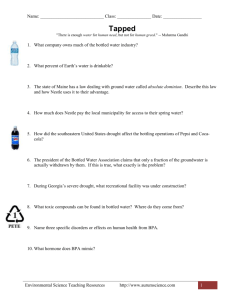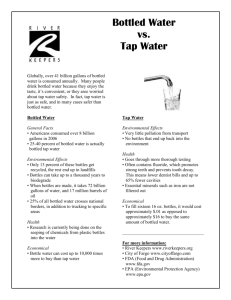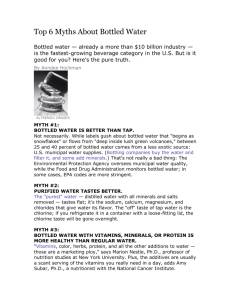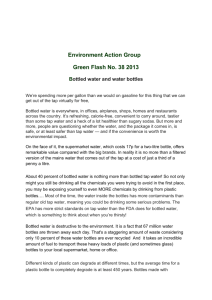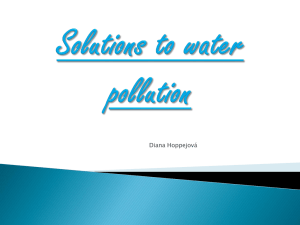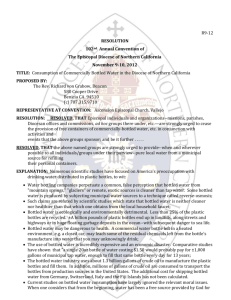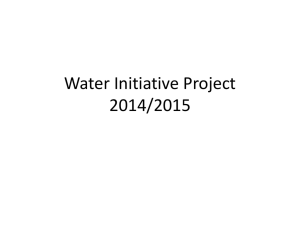Footnoted and Annotated Script
advertisement
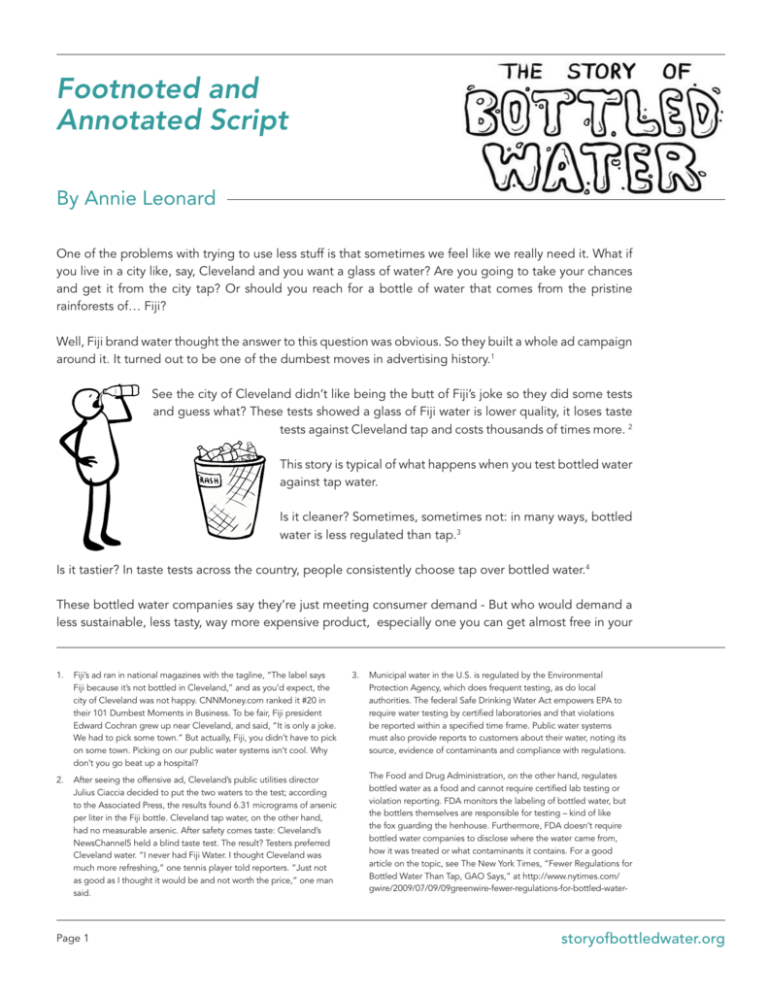
Footnoted and Annotated Script By Annie Leonard One of the problems with trying to use less stuff is that sometimes we feel like we really need it. What if you live in a city like, say, Cleveland and you want a glass of water? Are you going to take your chances and get it from the city tap? Or should you reach for a bottle of water that comes from the pristine rainforests of… Fiji? Well, Fiji brand water thought the answer to this question was obvious. So they built a whole ad campaign around it. It turned out to be one of the dumbest moves in advertising history.1 See the city of Cleveland didn’t like being the butt of Fiji’s joke so they did some tests and guess what? These tests showed a glass of Fiji water is lower quality, it loses taste tests against Cleveland tap and costs thousands of times more. 2 This story is typical of what happens when you test bottled water against tap water. Is it cleaner? Sometimes, sometimes not: in many ways, bottled water is less regulated than tap.3 Is it tastier? In taste tests across the country, people consistently choose tap over bottled water.4 These bottled water companies say they’re just meeting consumer demand - But who would demand a less sustainable, less tasty, way more expensive product, especially one you can get almost free in your 1. Fiji’s ad ran in national magazines with the tagline, “The label says Fiji because it’s not bottled in Cleveland,” and as you’d expect, the city of Cleveland was not happy. CNNMoney.com ranked it #20 in their 101 Dumbest Moments in Business. To be fair, Fiji president Edward Cochran grew up near Cleveland, and said, “It is only a joke. We had to pick some town.” But actually, Fiji, you didn’t have to pick on some town. Picking on our public water systems isn’t cool. Why don’t you go beat up a hospital? 2. After seeing the offensive ad, Cleveland’s public utilities director Julius Ciaccia decided to put the two waters to the test; according to the Associated Press, the results found 6.31 micrograms of arsenic per liter in the Fiji bottle. Cleveland tap water, on the other hand, had no measurable arsenic. After safety comes taste: Cleveland’s NewsChannel5 held a blind taste test. The result? Testers preferred Cleveland water. “I never had Fiji Water. I thought Cleveland was much more refreshing,” one tennis player told reporters. “Just not as good as I thought it would be and not worth the price,” one man said. Page 1 3. Municipal water in the U.S. is regulated by the Environmental Protection Agency, which does frequent testing, as do local authorities. The federal Safe Drinking Water Act empowers EPA to require water testing by certified laboratories and that violations be reported within a specified time frame. Public water systems must also provide reports to customers about their water, noting its source, evidence of contaminants and compliance with regulations. The Food and Drug Administration, on the other hand, regulates bottled water as a food and cannot require certified lab testing or violation reporting. FDA monitors the labeling of bottled water, but the bottlers themselves are responsible for testing – kind of like the fox guarding the henhouse. Furthermore, FDA doesn’t require bottled water companies to disclose where the water came from, how it was treated or what contaminants it contains. For a good article on the topic, see The New York Times, “Fewer Regulations for Bottled Water Than Tap, GAO Says,” at http://www.nytimes.com/ gwire/2009/07/09/09greenwire-fewer-regulations-for-bottled-water- storyofbottledwater.org THE STORY OF BOTTLED WATER kitchen? Bottled water costs about 2000 times more than tap water.5 Can you imagine paying 2000 times the price of anything else? How about a $10,000 sandwich? Yet people in the U.S. buy more than half a billion bottles of water every week. That’s enough to circle the globe more than 5 times.6 How did this come to be? Well it all goes back to how our materials economy works and one of its key drivers which is known as manufactured demand.7 If companies want to keep growing, they have to keep selling more and more stuff. In the 1970s giant soft drink companies got worried as their growth projections started to level off.8 There’s only so much soda a person can drink. Plus it wouldn’t be long before people began realizing that soda is not that healthy and turned back to – gasp – drinking tap water. Well, the companies found their next big idea in a silly designer product that most people laughed at as a passing yuppie fad.9 Water is free, people said back then, what will they sell us next, air?10 So how do you get people to buy this fringe product? Simple: You manufacture demand. How do you do that? Well, imagine you’re in charge of a bottled water company. Since people aren’t lining up to trade their hard earned money for your unnecessary product, you make them feel scared and insecure if they don’t have it.11 And that’s exactly what the bottled water industry did. One of their first marketing tactics was to scare people about tap water, with ads like Fiji’s Cleveland campaign. than-tap-g-33331.html Penta, an “ultrapremium” water. None was universally disliked. In a survey of 188 brands of bottled water, the Environmental Working Group (EWG) found only two providing such information about its product to consumers. Based on extensive research and testing, EWG developed a “bottled water scorecard” where you can compare brands, and learn more about the process of testing, labeling, and marketing bottled water: http://www.ewg.org/health/ report/bottledwater-scorecard-summary “We found that we were able to distinguish among two main types of water,” says the New York Times report. Natural spring, mineral and artesian waters, which have “a velvety feel across the tongue and a slightly flatter flavor,” and “purified waters, including tap water.” 4. In February, 2006, The New York Times submitted six bottled waters (a mix of domestic and imported, natural and purified) and one sample of New York City tap water for chemical analysis. Minerals like magnesium, calcium and even arsenic in trace amounts are expected in water, and nothing out of the ordinary turned up. In a bacteriological examination, six came back with results well within the parameters defined by the EPA. But one bottled spring water showed much higher levels of unspecified bacteria and was labeled “substandard for drinking water.” Because only one bottle was tested, the brand was not named. The Times then brought in its heavy hitters: the Restaurant Reviewers. In a blind tasting, The Times Dining staff sampled nine still waters: New York tap; Biota, a new Colorado spring water in a biodegradable bottle; Poland Spring from Maine; Aquafina, from Pepsi, the country’s best seller; Dasani, from Coca-Cola; Saratoga, a natural mineral water from upstate New York; Smartwater, “vapor-distilled and electrolyte-enhanced”; Fiji, artesian water from the South Pacific (artesian water comes from a deep underground source, such as an aquifer, that has no contact with surface air); and Page 2 Corporate Accountability International’s “Think Outside the Bottle” Campaign has held countless taste tests comparing bottled water to tap water, and the results generally favor the tap. But ultimately, the point isn’t whether one tastes better than the other – its how our taste, and our tastes, are shaped by advertising, rather than by what’s good for us. 5. The consumer advocacy group Food & Water Watch offers this assessment, from their Take Back the Tap report (http://www.foodandwaterwatch.org/water/pubs/reports/take-back-the-tap): “A quick calculation comparing the average cost of one gallon of tap water to one gallon of commercial bottled water comes out to: Tap water: $0.002 per gallon. Bottled water: Ranges from $0.89 to $8.26 per gallon.” Here’s how they break this out: “Pepsi’s Aquafina brand, which is nothing more than tap water further purified, registered $425.7 million in sales in 2005, followed by Coca-Cola’s Dasani bottled tap water with a sales tally of $346.1 million. Meanwhile, Nestlé’s Poland Spring brand, which does come from spring sources, rang up sales of $199.7 million. That all pencils out to bottled water costing consumers 240 to 10,000 times more per gallon than tap water that is as good, or better, and far more monitored.” Fortune magazine writer Marc Gunther paid $1.57 for a 20-ounce bottle of storyofbottledwater.org THE STORY OF BOTTLED WATER “When we’re done,” one top water exec said, “tap water will be relegated to showers and washing dishes.”12 Next, you hide the reality of your product behind images of pure fantasy. Have you ever noticed how bottled water tries to seduce us with pictures of mountains streams and pristine nature? But guess where a third of all bottled water in the U.S. actually comes from? The tap! Pepsi’s Aquafina and Coke’s Dasani are two of the many brands that are really filtered tap water.13 But the pristine nature lie goes much deeper. In a recent full page ad, Nestlé said: “bottled water is the most environmentally responsible consumer product in the world.”14 What?! They’re trashing the environment all along the product’s life cycle. Exactly how is that environmentally responsible? The problems start here with extraction and production where oil is used to make water bottles.15 Each year, making the plastic water bottles used in the U.S. takes enough oil and energy to fuel a million cars.16 All that energy spent to make the bottle even more to ship it around the planet and then we drink it in about 2 minutes?17 That brings us to the big problem at the other end of the life cycle – disposal. What happens to all these bottles when we’re done? Eighty percent end up in landfills, where they will sit Aquafina, Pepsi’s bottled tap water, and spent $3.05 for one gallon (128 ounces) of gas. A bit of math shows that his bottled water bill amounted to $10.05 per gallon: big profits for the bottlers. By comparison, most Americans pay about $2 per 1,000 gallons for municipal water service.” 6. In the intro to his book, Bottled and Sold: The Story Behind Our Obsession with Bottled Water (2010), Peter Gleick offers the figures like this: “…every second of every day in the United States, a thousand people buy and open up a plastic bottle of commercially produced water, and every second of every day in the United States, a thousand plastic bottles are thrown away. Eighty-five million bottles a day. More than thirty billion bottles a year at a cost to consumers of tens of billions of dollars.” To get back to Annie’s number, that eighty-five million bottles a day, times seven days a week, gives us 595 million bottles a week. We asked the experts to do a little more math for us, and here’s what they came up with: Renee Sharp, Director of the California Office of Environmental Working Group offered the following calculation: “Assuming each bottle is 8 inches high, which is the height the 20 fl. Oz. Aquafina bottle I have on my desk for just this reason, 1 billion bottles would circle the globe 5.4 times, or would span the distance between Los Angeles and Tokyo 23 times.” Peter Gleick of the Pacific Institute says, “I also calculated that the bottles would circle the Earth 5 times. But I assumed 600 million bottles (which I think is a more accurate number than a billion) and 12 inches high each (I didn’t have a bottle on my desk to measure...).” The 600 million 12-inch bottles is more akin to Annie’s “more than half a billion bottles every week” being “enough to circle the globe more than 5 times.” Page 3 You know, when you’re talking about numbers this big and planets this fragile, unique, and essential to supporting all life, it’s good to consult a variety of sources… 7. Manufactured demand is a desire for something that didn’t just develop naturally but was stoked by some outside force. Manufacturing demand is a core strategy of today’s consumer economy. In order to get people to keep buying stuff, when most of us have plenty of stuff already, companies manufacture demand so we feel like we need ever more and ever newer clothes, cars, toasters, furniture, shoes…everything. I mean, it’s not like any of us just woke up and said “I need, really need, a new cell phone to replace my perfectly functional one” or “ I really need a 15th pair of shoes.” The main tool to promote manufactured demand is advertising. In the past, advertising served to make announcements (“just arrived!”) and then to distinguish products from one another, advertising’s main role these days is to manufacture demand: to convince us we will be more successful, more happy, more loved if we just had a new (insert any consumer good here.) Now sometimes we really do need something, but a real need is different than manufactured demand. And manufactured demand has become so omnipresent that sometimes we get confused. It’s not just bottled water; it’s all over the place. Look around. Next time you’re about to lay out some hard-earned cash for something, stop for a minute and ask yourself: do I really need this or am I responding to the bombardment of messages convincing me I need this? Our friends at Polaris Institute tell us, “The real market value of bottled water lies in its perceived social value, a perception companies have worked hard to create. Between 10% to 15% of the storyofbottledwater.org THE STORY OF BOTTLED WATER for thousands of years,18 or in incinerators, where they are burned, releasing toxic pollution.19 The rest gets collected for recycling. I was curious about where the plastic bottles that I put in recycling bins go. I found out that shiploads were being sent to India.20 So, I went there. I’ll never forget riding over a hill outside Madras where I came face to face with a mountain of plastic bottles from California. Real recycling would turn these bottles back into bottles. But that wasn’t what was happening here. Instead these bottles were slated to be downcycled,21 which means turning them into lower quality products that would just be chucked later. The parts that couldn’t be downcycled were thrown away there; shipped all the way to India just to be dumped in someone else’s backyard. If bottled water companies want to use mountains on their labels, it’d be more accurate to show one of those mountains of plastic waste. Scaring us, seducing us, and misleading us – these strategies are all core parts of manufacturing demand. Once they’ve manufactured all this demand, creating a new multibillion dollar market,22 they defend it by beating out the competition. But in this case, the competition is our basic human right to clean, safe drinking water.23 Pepsi’s Vice Chairman publicly said “the biggest enemy is tap water!”24 They want us to think it’s dirty price of a bottle of water goes to cover advertising costs.” (http:// www.bottledwaterfreeday.ca/index2.php?section_id=21) This means we’re actually paying to be manipulated by advertising. 8. An article in the Financial Times of May 5, 1983, titled Marketing: Coke plugs market gap, describes the trend, in part: “NEVER-A-PLACE for the faint-hearted, the US soft drinks industry is today locked in a competitive battle which could prove to be just too much for some of the weaker contestants. The latest sally comes from the strongest of them all, Coca-Cola. This time last year, Coke had only two cola products on the market: after the launch of three new products this week, it now has six. The proliferation of brands in this way has become common in the industry, probably because the overall growth in the market place is not what it was. US soft drink consumption, which was rising at an annual 6 per cent or more until the late 1970s, has been increasing at less than 3 per cent a year since 1980, and, as a result, the manufacturers are hunting for growth at each other’s expense. Coke had a big success with last year’s new product, Diet Coke, which it is now launching in the UK with a Pounds 1.5m ad campaign starting this month (see this page April 7). It is now moving into Page 4 another segment of the market which is being expanded by health conscious Americans - caffeine free colas.” 9. Those of you old folks in the audience (that’s Generation X and beyond) may recall Orson Welles, circa 1977, gushing on television about “a place in the south of France where there is a spring, and its name is Perrier.” That was the first ever television ad for bottled water, and thus began one of the most baffling cons in modern consumerism. The sad fact, though, is that it wasn’t a passing Yuppie fad: in the three years following that ad, American sales of Perrier went up more than 3,000 percent. Speaking to the New York Times for an article of February 15, 2006 (“There Must be Something in the Water”), New York resident Johanna Raymond recalled, ‘’I remember thousands of us running in Perrier T-shirts in the 1979 marathon. Perrier was the coolest thing then. It was more than water.’’ 10. Another retro reference: in the 1987 screwball comedy Spaceballs, Mel Brooks pops open a can of Perri-Air, brings it to his nose and takes a deep breath of the pure oxygen. Twenty years later, it just goes to show that reality is stranger than science fiction. 11. When Fiji’s ad said, “It’s not bottled in Cleveland,” the underlying message was, “because Cleveland’s water is dirty and dangerous.” Which is, in fact, not true, but this was the message that the bottled water industry had planted in our collective imaginations. storyofbottledwater.org THE STORY OF BOTTLED WATER and bottled water is the best alternative. In many places, public water is polluted thanks to polluting industries like the plastic bottle industry!25 And these bottled water guys are all too happy to offer their expensive solution26 which keeps us hooked on their product. It’s time we took back the tap. That starts with making a personal commitment to not buy or drink bottled water unless the water in your community is truly unhealthy.27 Yes, it takes a bit of foresight to grab a reusable bottle28 on the way out, but I think we can handle it. Then take the next step -- join a campaign that’s working for real solutions. Like demanding investment in clean tap water for all. In the US, tap water is underfunded by $24 billion29 partly because people believe drinking water only comes from a bottle! Around the world, a billion people don’t have access to clean water right now.30 Yet cities all over are spending millions of dollars to deal with all the plastic bottles we throw out.31 What if we spent that money improving our water systems or better yet, preventing pollution to begin with? There are many more things we can do to solve this problem. Lobby your city officials to bring back drinking fountains.32 Work to ban the purchase of bottled water by your school, organization or entire city.33 This is a huge opportunity for millions of people to wake up and protect our wallets, our health and the planet. The good news is: it’s already started. Bottled water sales have begun to drop34 while business is booming for safe refillable water bottles.35 Yay! Polaris Institute breaks it down: “Wherever there are incidents of contamination or disruption in municipal water systems, companies have been quick to respond with the promise of security, playing on fears about the spread of germs and toxins and a growing lack of faith in governments’ ability to provide security through reliable public services.” (http://www.bottledwaterfreeday.ca/index2. php?section_id=21) Its curious to note that the marketing of bottled water took off in North America in the 1990s, precisely when cigarette smoking, the fast food industry and the soft drink industry were coming under fire for promoting unhealthy lifestyles. By using images of waterfalls and pristine mountain springs, by associating bottled water with a healthy lifestyle, and by turning it into a status symbol, the bottled water industry has been successful at creating a mass market for their product. A variety of marketing techniques are used to associate bottled water with images of ‘activity,’ ‘health,’ ‘relaxation,’ and ‘pureness.’ In her book Bottlemania (2008), Elizabeth Royte refers to ads for Glaceau water “which ask, ‘Who Approved Your Water?’ The copy claims that tap water is ‘rejected by Mother Nature’; springwater is Page 5 approved by nature ‘for potty training animals’ (accompanied by an ideogram of a fish pooping); and purified water is approved by the FDA, but ‘investigated by the FBI’ (with an ideogram of a belching factory.)” (Royte, Bottlemania, 34) In Bottled and Sold: The Story Behind our Obsession With Bottled Water, Peter Gleick tells of an ad received in the mail from Royal Spring, a Texas bottled water company, that said “Americans no longer trust their tap water … Clearly people are more worried than ever about what comes out of their taps.” (Gleick, Bottled and Sold, 7). It is these kinds of underhanded marketing techniques that lead us to believe that tap water is dangerous and deadly, often despite any legitimate evidence. As it turns out, from the big picture perspective, if you take into account the real harm from pollution and waste that can be traced directly to the beverage industry, the real danger lies with them… 12. The quote is from Susan D. Wellington, president of the Quaker Oats Company’s United States beverage division, which makes Gatorade, speaking before industry analysts in 2000. (See Peter Gleick, Bottled and Sold, 7.) 13. An article of July 27, 2007 on CNN.Money.com said: “Pepsi-Cola announced Friday that the labels of its Aquafina brand bottled water will be changed to make it clear the product is tap water. The new storyofbottledwater.org THE STORY OF BOTTLED WATER Restaurants are proudly serving “tap”36 and people are choosing to pocket the hundred or thousands of dollars they would otherwise be wasting on bottled water. Carrying bottled water is on its way to being as cool as smoking while pregnant. We know better now. The bottled water industry is getting worried because the jig is up. We’re not buying into their manufactured demand anymore. We’ll choose our own demands, thank you very much, and we’re demanding clean safe water for all. bottles will say, ‘The Aquafina in this bottle is purified water that originates from a public water source,’ or something similar, PepsiCola North America spokeswoman Nicole Bradley told CNN. CocaCola does not have plans to change the labeling on its Dasani brand bottled water, a company spokesman told CNN, despite the fact the water also comes from a public water supply.” Read the article, here: http://money.cnn.com/2007/07/27/news/companies/pepsi_coke/ Council of Canadians: “When the carbon footprint of drinking out of your tap is zero, you can’t deny that the environmental impact of bottled water is more harmful.” Now, the companies go to great length to tell you that, while their water originates from a public water source, it is more than “just filtered tap water.” They boast proprietary, state-of-the-art, multi-stage filtration processes and esoteric references to mineral additives that make their water more than just water, and certainly better than tap. But, as Tony Clarke of Canada’s Polaris Institute points out in his book, Inside the Bottle (2005), “unlike other resource production processes, where raw materials like timber, minerals, and oil are transformed into new products, bottled water is different. Bottled water is about ‘turning water into water.’” (Inside the Bottle, 54.) In fact, to say that tap water (or anything, for that matter) has no carbon footprint might be an exaggeration, but a recent study commissioned by the Oregon Department of Environmental Quality called “Life Cycle Assessment of Drinking Water Delivery Systems: Bottled Water, Tap Water and Home/Office Delivery Water,” (http:// www.deq.state.or.us/lq/sw/wasteprevention/drinkingwater.htm) concludes that “consuming water from the tap in an average reusable bottle, even if washed frequently in a highly inefficient dishwasher, reduces energy consumption by 85 percent and greenhouse gases by 79 percent…Even the best performing bottled water scenario has global warming effects 46 times greater than the best performing tap water scenario.” Which is to say, choosing tap water is not only good for your budget, it’s an important way to reduce global warming. 14. The ad ran in Canada’s Globe and Mail, October 20, 2008, page E7; you can see it here: http://www.ecojustice.ca/media-centre/mediarelease-files/2008.12.01--globe--nestles-complaint.pdf. The ad caused such a stir among environmentalists that it merited an entire article in This Magazine titled “‘Environmentally friendly’ Bottled Water? No such thing” (http://this.org/magazine/2009/05/15/environment-water-bottle/). The article concludes with a sharp observation by Meera Karunananthan, the national water campaigner for the 15. Most plastic water bottles are made of PET plastic, or polyethylene terephthalate, which is made from crude oil. The invention of PET in the 1970’s made the portable water bottle possible. While plastic is everywhere because it is probably the most convenient material ever made, it comes at a high price. Back in 1993, the Glass Packaging Institute put out a report comparing glass and plastic, in which they noted that, “The production of the organic chemical industry has increased by a factor of ten over the past 40 years, a rate which Page 6 storyofbottledwater.org THE STORY OF BOTTLED WATER has far outstripped total industrial production. In the U.S., plastics production has increased from 6 billion pounds in 1960 to 58 billion pounds in 1989. A major consumer of plastic production is the packaging industry, and containers account for nearly half of the total packaging material sales.” (And this was before the bottled water boom…) The report goes on: “The post-war boom in plastic and other petrochemicals has lead to an enormous rise in the volume and toxicity of hazardous chemicals and wastes in the environment. The number of chemicals used and released that are known to cause cancer, birth defects and damage to reproductive systems has increased dramatically.” (Advantage Glass! Switching to Plastic is an Environmental Mistake, by Henry S. Cole, Ph.D. and Kenneth A. Brown, 1993, 60.) So much for bottled water being healthy…. 16. The Pacific Institute breaks it down like this: “Because bottled water required approximately 1 million tons of PET in 2006, those bottles required roughly 100 billion MJ of energy. A barrel of oil contains around 6,000 MJ, so producing those bottles required the equivalent of around 17 million barrels of oil. This is enough energy to fuel one million American cars for one year.” The rest of the details can be found in Pacific Institute’s fact sheet on the topic, here: http://www.pacinst.org/topics/integrity_of_science/case_studies/bottled_water_factsheet.pdf 17. Two minutes, three minutes, four minutes, whatever…The point is, it takes A LOT of energy and resources to produce a plastic bottle that is meant to be used exactly ONCE. In The Story of Stuff Annie talks about “planned obsolescence”: “Planned obsolescence is another word for ‘designed for the dump.’ It means they actually make stuff that is designed to be useless as quickly as possible so we will chuck it and go buy a new one. It’s obvious with stuff like plastic bags and coffee cups, but now it’s even big stuff: mops, DVDs, cameras, barbeques even, everything!” A couple of Annie’s favorite books on the topic are The Waste Makers (1960) by Vance Packard, and Made to Break (2006) by Giles Slade. 18. According to the Container Recycling Institute (http://www. container-recycling.org/), in fact, 90 percent of PET bottles end up in landfills, where they take between 450 and 1000 years to break down. In addition, a 2004 report from the Container Recycling Institute (The 10¢ Incentive to Recycle, by Jenny Gitlitz and Pat Franklin, CRI, 2004) tells us that “Beverage containers make up 4.4 percent of the waste stream and 40 to 60 percent of roadside litter,” and goes on to say that “While municipal curbside recycling programs rippled nationally during the 1990’s, they have been unable to keep up with increasing sales of single-serving beverages and away-from-home consumption of food and drinks. An estimated 118 billion beverage bottles and cans were landfilled, littered, or incinerated in 2002 – 83 percent more than were wasted in 1992, and more than twice the amount wasted in 1982.” “Indian environmentalists, working with investigators from Greenpeace’s International Toxic Trade Project, have discovered that Pepsi is involved in both producing and disposing of plastic waste in India. Under Pepsi’s two-part scheme, plastic for single-use disposal bottles will be manufactured in India and exported to the United States and Europe, while the toxic by-products of the plastic production process will stay in India. Used plastic bottles will then be returned from these countries to India. India will bear the burden of environmental and health impacts from plastic production and plastic waste, while consumers in industrialized countries will be able to continue using and disposing of massive quantities of unsustainable and unnecessary beverage packaging without absorbing the true costs - financial, health and environmental. In short, India gets shafted at both ends, while industrialized country consumers receive all the benefits. Activists first learned of Pepsi’s waste exports to India through U.S. Customs Department Data. Greenpeace researchers discovered records listing Pepsi as the exporter of about 4,500 tons of plastic scrap in 23 shipments during 1993. The U.S. Customs records indicated that all of the waste exports were destined for the Southern Indian City of Madras. All of the shipments left from the U.S. West Coast: eight shipments from San Francisco, two shipments from Long Beach, 10 from Los Angeles, and three from Oakland. The most frequently used shipping lines for these waste shipments were OOCL and Presidential. Much of the waste was dumped at the site of a factory owned by Futura Industries in Tiruvallur, outside of Madras. ‘As we came over the hill in our auto-rickshaw, we saw a mountain of plastic waste,’ recounts Madras environmentalist Satish Vangal, one of the researchers who discovered the site. “Piles and piles of used soda bottles stacked behind a wall. When we got closer to the factory, we found many bottles and plastic scrap along the road and blowing in the wind. Every bottle we saw said ‘California Redemption Value.’ They were all from California’s recycling program and now they are sitting in a pile in India!’ explains Vangal. ‘We have enough problems dealing with our own plastic wastes; why should we import other peoples’s rubbish?’ Pepsi officials in the United States acknowledge the waste is exported to India, but claim it is all recycled. Futura officials also say the waste is imported, but they admit that much of it is not actually recycled. The senior manager of the Futura plant, Dr. L.R. Subbaraman, estimated that 60 to 70 percent of the waste can be processed at his factory, but the rest is either too contaminated with residual materials or other garbage that arrives mixed in with the shipment, or is the wrong type of plastic. Subbaraman refused to disclose the fate of the waste which cannot be reprocessed at the plant. 19. Some good facts on incinerators can be found at http://www. zerowasteamerica.org/Incinerators.htm. To get more in-depth, see Incineration: A Dying Technology by Neil Tangri (2003); Gone Tomorrow by Heather Rogers (2005) and “Landfills Are Dangerous” in Rachel’s Democracy and Health News, September 24, 1998, and Incineration and Human Health by Pat Costner, Paul Johnston, Michelle Allsopp (2001) Subbaraman reports that Futura has imported a total of 10,000 metric tons of plastic waste from Pepsi and other companies since 1992. If only 60 to 70 percent could be processed within the Futura plant, 3,000 to 4,000 metric tons of plastic garbage have been imported which were not recyclable. A visit to the back of the plant revealed a massive pile of plastic discards.” 20. Annie wrote about one such case way back in 1994 in Multinational Monitor: Find Annie’s entire article at: http://www.mindfully.org/Pesticide/ Dumping-Pepsi-Plastic-India94.htm Page 7 storyofbottledwater.org THE STORY OF BOTTLED WATER 21. Most plastic “recycling” is actually “downcycling.” In Cradle to Cradle: Remaking the Way We Make Things (2002) architect William McDonough and chemist Michael Braungart tell us that when most plastics are recycled, they are mixed with different plastics to produce a hybrid of lower quality, which is then molded into something amorphous and cheap, such as a park bench or a speed bump. This tells us that even something as “environmentally friendly” as recycling still does not really bring about sustainable use of resources, it just moves our waste around the built environment in ever-more degraded forms. Even worse, McDonough and Braungart say that “Downcycling can actually increase contamination of the biosphere,” (Cradle to Cradle, 57), because the process releases toxins, and because, “Since downcycled materials of all kinds are materially less rigorous than their predecessors, more chemicals are often added to make the materials useful again.” 22. When numbers get this big, they’re hard to track, but here are a few: The U.S. Census Bureau (http://www.census.gov/PressRelease/www/releases/archives/miscellaneous/007871.html) reports that Americans drank 23.2 gallons of bottled water per capita in 2004, up from only 2.7 gallons in 1980. Another report says we drink less, but still a lot: “The average American drinks approximately 14 gallons of bottled water a year. Assuming a population of 250 million, this comes to a staggering 13 billion liters (13 Gl = 13 gigaliters).” USEPA quotes the Beverage Marketing Corporation of 2004 (http://www.epa. gov/ogwdw000/faq/pdfs/fs_healthseries_bottlewater.pdf) to tell us that “Bottled water is the fastest growing drink choice in the United States, and Americans spend billions of dollars each year to buy it.” One report (http://www.fastcompany. com/magazine/117/features-message-in-a-bottle.html) tells us that in 2007, Americans spent more money on bottled water than on ipods or movie tickets: $15 Billion. 23. If asked, “Is water a human right?” most of us would say “Of course!” without blinking an eye. And it is…sort of. But because “human rights” is a big complicated field of legal and technical concerns, it can get a little … sticky. The Universal Declaration of Human Rights, the founding document of modern human rights law, for example, says nothing specifically about water. When it was written in the 1940’s it would’ve been hard to imagine companies buying and selling water in a way that denied it to anyone, so making water a human right would have seemed as silly as making air a human right. The document does say we all have the right to life, to health, to dignity, security, etc…But nothing about water. Of course, without water, there’s no life, health, dignity, or security, so…. The Universal Declaration protected what are called “political rights.” Only later did it become clear that we needed protections also of what are called “economic, social, and cultural rights.” In 2002, partly in response to growing concerns that poor people worldwide were being forced to pay for water or go without, the United Nations Committee on Economic, Social, and Cultural Rights wrote General Comment No.15, which is now considered the definitive and official interpretation of human rights laws regarding water. The whole thing can be read here: http://www.righttowater.info/code/No15.asp For those of you who may not have time to read the whole thing, the gist of General Comment 15 is in its introductory paragraph: ‘the human right to water entitles everyone to sufficient, safe, acceptable, physically accessible and afford- Page 8 able water for personal and domestic uses’. It notes that the right to water has been recognized in a wide range of international documents and reaffirms the fundamental importance of the right stating that: ‘the human right to water is indispensable for leading a life in human dignity. It is a prerequisite for the realization of other human rights’. 24. This quote is from Robert S. Morrison, quoted in 2000, shortly before he was made chairman of Pepsico’s North American Beverage and Food division. The full quote is: “The biggest enemy is tap water … We’re not against water—it just has its place. We think it’s good for irrigation and cooking.” Both this and the earlier citation, from Susan D. Wellington, are cited in a letter to the New York Times by Peter Gleick of the Pacific Institute, here: http://www.nytimes.com/2001/08/24/opinion/ltap-water-in-a-bottle-842370.html?scp=2&sq=water%20 bottle&st=cse, and in Peter Gleick’s book, Bottled and Sold: The Story Behind Our Obsession With Bottled Water, page 7. 25. … and the oil industry …. and the mining industry … and big agribusiness … That is to say, the manufacturing of demand that we associate with bottled water leads to pollution such as that Annie wrote about back in 1994 (http://www.mindfully. org/Pesticide/Dumping-Pepsi-Plastic-India94.htm) and stunning pollution disasters like the great Pacific garbage patch, a floating dump the size of Texas, containing shoes, toys, bags, pacifiers, wrappers, toothbrushes, and bottles -- approximately 3.5 million tons of trash – out in the ocean midway between Hawaii and San Francisco (http://www.greatgarbagepatch. org/). The same “manufactured demand” leads to massive overconsumption of fossil fuels and the pollution it causes (http://chevrontoxico.com/), an industrial system of agriculture that leaves toxic pollution in its wake, (http://www.greenpeace. org/seasia/en/news/agrochemicals-a-major-source-o), and mining for energy and mineral demand that is way out of control (http://www.earthjustice.org/news/press/2010/scientists-agreemountaintop-removal-mining-is-destroying-appalachia.html). That is to say, bottled water is a big problem….But it is also a symptom of a much bigger problem: using too much stuff, and leaving too much waste. 26. We’ve already covered the “expensive” part; for some critical thinking on the “solution” part, see the next footnote… 27. At the heart of the water issues is the fact that literally billions of people around the world – including in parts of the U.S. and other rich countries – do not have access to safe drinking water. The causes are complex, including both man-made political and economic causes, and natural causes; in short, it might be the water, it might be the pipes – or it might be the lack of water or the lack of pipes. In either case, selling bottled water (or even giving it away as some companies and organizations do as part of relief efforts in emergencies), will not fix the problem. The real fix is more public investment in water infrastructure, and community control of that infrastructure to ensure that the poorest and most vulnerable communities have their needs met. Even in places where both tourists and locals are urged to “not drink the water,” the long-term solution is not to avoid tap water – but to make the tap water safe to drink. Yes, this solution will cost money, but at least its an investment in something permanent, and that benefits everyone. 28. …or mug … or mason jar … or sippy cup … or ... With all the storyofbottledwater.org THE STORY OF BOTTLED WATER empty containers in your kitchen and all the good water flowing from the tap, there’s no reason not to carry one. 29. By “underfunded,” we mean the difference between what is currently spent and is projected to be spent on water infrastructure investment, and what will actually need to be spent during that same time period to keep service levels roughly comparable to desirable past and current service levels. The $24 billion projection is based on the rough averaging of two water infrastructure investment gap analyses conducted by the EPA (U.S. Environmental Protection Agency, “The Clean Water and Drinking Water Infrastructure Gap Analysis,” September 2002, EPA 816-R-02-020, 50, http://www.epa. gov/OGWDW/gapreport.pdf) and by the Water Infrastructure Network, a coalition of labor, environment and water utility officials (see Water Infrastructure Network, Clean & Safe Water for the 21st Century, A Renewed National Commitment to Water and Wastewater Infrastructure, April 2000). For a more detailed explanation, see the Congressional Research Service’s 2008 report, “Water Infrastructure Needs and Investment: Review and Analysis of Key Issues” (http://fas. org/sgp/crs/homesec/RL31116.pdf). 30. More precisely, 1.2 billion people lack access to safe water and 2.6 billion lack access to sanitation, according to the UN Development Program’s 2006 Human Development Report (http://hdr.undp.org/en/reports/global/hdr2006/). 31. Bill Sheehan, Director of the Product Policy Institute (http:// www.productpolicy.org/), says “Three-quarters of the waste material that local governments are responsible for managing in North America is products and packaging; the costs of collecting PET bottles alone runs about $900 per ton. That amounts to welfare for the makers of products and packaging. Citizens and their governments would be better served if those funds were supporting schools, police and parks, and other services that the market cannot or will not provide, like public water fountains … In a time of tight budgets many local governments are asking why taxpayers and ratepayers, and not producers and consumers, are the ones paying to pick up products and associated packaging ‘designed for the dump.’ The costs of recycling and litter clean up should be the responsibility of producers and included in the purchase price.” 32. Anyone remember water fountains? Coincidentally, just before the bottled water craze hit, it was taken for granted that public fountains were part of any public building: schools, offices, sports stadiums, parks. Where did they go? Polaris Institute in Canada has followed the story in that country, here: http:// www.insidethebottle.org/bottled-or-tapped-out-where-haveall-water-fountains-gone. Meanwhile, in the U.S., many state building codes mandate that there be one source of public water for every 1000 people the building has capacity for. This came up in recent news in two cases: In Cleveland (why always Cleveland?), the new sports arena that hosts the Cleveland Cavaliers basketball team removed its drinking water fountains. The only way for thirsty fans to get water was to wait in line at the concessions counter for a free small cup or pay $4 for bottled water – or try to drink water from the bathroom faucets. As Peter Gleick of Pacific Institute wrote, “This wasn’t the first time a sports arena ran into trouble over water fountains. In September 2007, the University of Central Florida opened its brand new 45,000 seat Page 9 football stadium with a sell-out crowd on hand to watch the UCF Knights battle the Texas Longhorns. The loser? The fans. With temperatures near 100 degrees the crowd found out the hard way that the stadium had been built without a single drinking fountain (in apparent violation of building codes). Security concerns kept out personal water bottles. And the only water available (other than the taps in the bathrooms) was $3 bottled water, which quickly sold out. Eighteen people were taken to local hospitals and sixty more were treated by campus medical personnel for heat-related illnesses. After a massive public brouhaha, the University quickly retrofitted the stadium with water fountains.” (http://www.sfgate.com/cgibin/blogs/gleick/detail??blogid=104&entry_id=56985) The public fountains were brought back at the Cleveland Cavaliers’ stadium, too. The lesson? We like our drinking fountains; in fact, we don’t just like them…We need them for public health and safety. The other lesson? When people organize to take back our right to public water…we win. 33. Bottled water bans are spreading faster than we can count. The Polaris Institute in Canada says that as of December, 2009, 72 municipalities from 8 provinces and 2 territories had implemented restrictions on bottled water. (http://www. wiserearth.org/article/7ccceaf282e8aa3514b2f3e309ed2cb6) In the U.S., San Francisco, Minneapolis, Seattle, and Salt Lake City have all banned bottled water at city functions as a way of reducing budgets while promoting their cities’ highly drinkable tap water (and these are just the big cities). At the 75th annual Conference of Mayors the mayors of these three cities introduced a resolution to ban bottled water in city functions nationwide. 34. The Beverage Marketing Corp. documents sales trends of bottled water, soft drinks, fruit juice and many other kinds of drinks. Its data shows that bottled water sales fell 1 percent in 2008 to 8.7 billion gallons, down from 8.8 billion gallons in 2007. In 2009, the company reported, sales remained depressed, on a par with 2008. The biggest hit was taken by Nestle, the Swiss company that is the world’s biggest seller of bottled water under such brand names as Perrier, Poland Springs, San Pellegrino and Deer Park. The company reported that the volume of its bottled water sales fell 3.7 percent in the first half of 2009. A report by the WorldWatch Institute (http:// www.worldwatch.org/node/5878) gives the details. Behind the story are some grisly details of what an industry does when its market share is under threat. Richard Girard of Polaris Institute wrote an in-depth article on that topic, here: http://www.stopcorporateabuse.org/alternet-bottled-waterindusty-faces-downward-spiral 35. Many companies now sell safe, easy-to-clean, lightweight drinking water bottles; we found a pretty hefty selection available here: http://www.reusablebags.com/store/bottlesaccessories-c-19.html. Our partners at Food & Water Watch and Corporate Accountability International offer sleek, stainless steel water bottles to their members. 36. Food & Water Watch, which has been supporting restaurants nationwide in making the switch back to good old tapwater, even offers a handy guide to the topic: http://www.foodandwaterwatch.org/water/bottled/restaurants storyofbottledwater.org
